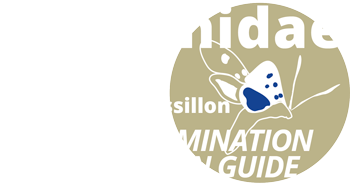The Zygaenidae family | Burnet and Forester moths
Burnet and Forester beginners’ guide
A day flying moth …
Because of their primarily daytime activity and club-shaped antennae, rather like those of butterflies, the Burnet and Forester moths are usually considered as “butterflies” or Rhopalocera. However, if we look closer at the underside of the wings, there is a coupling of the forewing to the hind wing. This coupling is a characteristic of Heterocera, more commonly known as “moths”.
The origin of the word Zygaena
The Latin zygaena, derived from the Greek zygaina, means “hammer-headed” and refers to the shape of antennas. The entomologist Étienne Louis Geoffroy (1725 – 1810) gave them the name “Sphinx-Béliers” because of the strong resemblance of the antennas to those of hawk or sphinx moths, and because of the “threatening” ram-like appearance of the antennas.

Cinnabar moth
Not to be confused with …
The Cinnabar moth, Arctiidae (Erebiidae) family, (Tiger moths) is named after the red mineral cinnabar because of the red patches on the predominantly black wings, showing a long red line and two marginal spots on the forewings.
Meet the families …
In France, the Zygaenidae family is comprised of three groups (subfamilies) Procridinae, Chalcosiinae and Zygaeninae. There is a 4th subfamily, which is not present in France.

Procridinae Adscita mannii
Jean-Pierre Favretto
Forester moths (Procridinae)
Generally discrete, it is almost impossible to distinguish related species without examination of genitalia. There are nine known species in the Midi-Pyrénées and Languedoc-Roussillon.

Rhagades pruni
Philippe Mothiron/lepinet.fr
Rhagades pruni is the one Procridinae species that can be identified in the two regions, due to the sombre wings and antennae and the blue-green thorax, it is, however, very discrete in the adult stage.
Chalcosiinae

Aglaope infausta
Phillipe Mothiron/lepinet.fr
Aglaope infausta (Almond-tree leaf skeletonizer moth) is the only member of this sub-family present in Europe. It can be identified by its black forewings, reddish hind wings and red collar.

Zygaena contaminei (Sienna Burnet)
Jude Lock/ borderlinehols.com
Zygaeninae
Burnet moths (black moths with red spots)
This ID key represents the 21 known species of the Midi-Pyrénées and Languedoc-Roussillon.
Further reading: Guide des Zygènes de France by Alain Hérès (Association roussillonnaise d’entomologie, 2011). This book covers all the species found in France (in French).

